Most of us have probably had a moment (or many) throughout our lives where we’ve said, “What in the world is that smell?” Whether good or bad, scents help us identify things in our surroundings and, in some cases, can alert us to danger. Gas and frayed electrical wires are a few, but indoor contaminants can also create an odor that signifies their presence. That begs the question, though, “Does mold have a smell?”
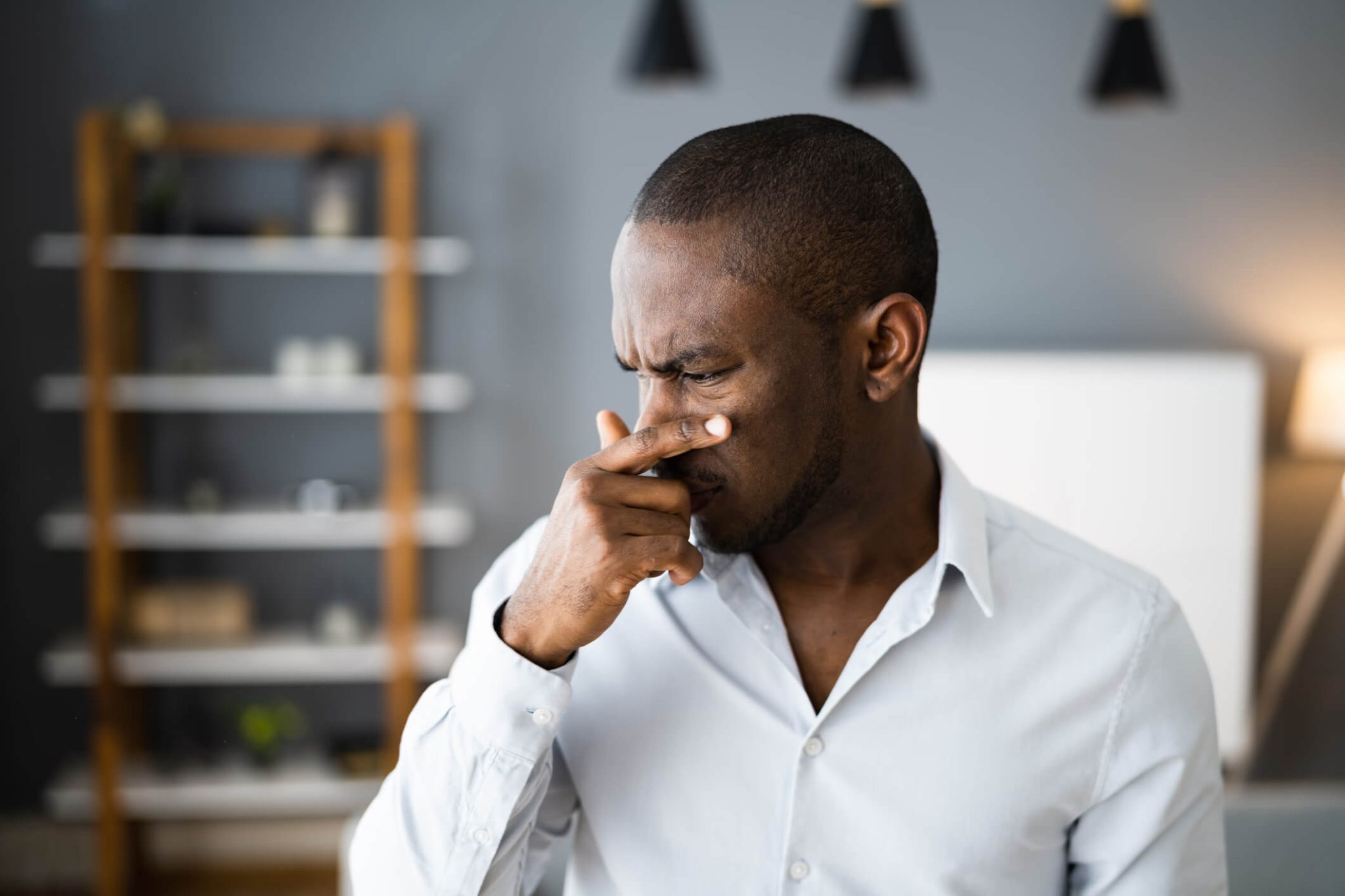
SO, DOES MOLD SMELL?
The short answer is: it depends. While mold inherently doesn’t smell, some species do create an odor as they grow based on biological processes. Let’s break that down to understand the process better.
WHY DOES MOLD SMELL?
There are over 100,000 species of mold identified by researchers so far. While all of them create spores, some also produce gases called microbial volatile organic compounds (MVOC) during certain parts of the growth cycle. This off-gassing varies based on the species of fungus and the environmental situation in which the colony is growing.
These MVOCs are what give off that strong, distinctive smell that mold releases. Again, though, not all species create the chemicals that give off this odor, so while some mold growth may smell, another may have no odor at all. Hence, why the answer to “Does mold smell?” is, “Yes, but not all the time.”
WHAT DOES MOLD SMELL LIKE?
The MVOCs released by mold often create an odor that’s described as musty, earthy, and damp. When this odor occurs, it generally points to a mold issue in the surrounding area.
Many individuals have probably experienced this smell when food has turned rotten. One of the contributing factors to that yucky smell is mold growth. Mold in a home can have a similar odor, but it’s more clearly defined.
DOES MOLD SMELL? SOMETIMES, BUT IS IT A PROBLEM?
A common misconception about mold is that since it’s everywhere, it’s no problem when it grows within a home. True, colonized mold exists all across the planet and is constantly releasing those microscopic particles. However, these microscopic particles have the entire world to disperse through.
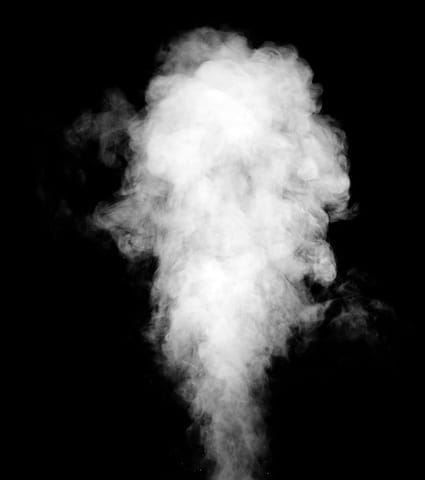
When mold grows in a home, the situation is entirely different. Thanks to modern building practices pushing for net-zero energy efficiency, there’s very little air flow between indoor and outdoor environments. What that means is that most of the spores and potentially mycotoxins released by the colonized mold in a home remain in that indoor environment and will continue to build up as long as it continues to survive and thrive.
This level of exposure is much different than encountering a few mold particles throughout the day while driving to work or walking into the grocery store. Exposure to this higher volume of mold can trigger a long list of adverse health reactions. Knowing the answer to “Does mold smell? ” can help identify a problem so that this health impact can be mitigated.
THE HEALTH IMPACT OF EXPOSURE
The size of the particles in question plays a big role in the ability of mold to cause a bodily reaction. Both mold spores and mycotoxins are measured in a unit called microns, which is 1/1,000 of a millimeter. A better mental image is to imagine lining up 1,000 microns, and that would equal the distance between the two tiny lines on a ruler.
This small size allows the particles to enter the body either through inhalation, ingestion, or absorption.⁶ Once inside, the body tags them as foreign invaders and deploys the immune system to get rid of them as soon as possible. The immune response often leads to adverse health reactions. As more and more particles enter the body, the immune system can become overwhelmed, overloaded, and malfunction. This leaves the door wide open for chronic symptoms and related conditions.⁷’⁸’⁹’¹⁰’¹¹
All of that being said, no two people respond to exposure the same way. Some may develop the occasional runny nose, and others may experience over 30 symptoms. Researchers are still attempting to figure out the mechanisms behind mold’s ability to affect the body and to what extent this impact can be. Various factors make it a tricky subject to nail down.
THESE FACTORS INCLUDE:
- Genetics: Some individuals are predisposed to be more sensitive to mold exposure. For example, a few studies have started linking those with the HLA-DR as hypersensitive because their body’s immune system does not respond properly to toxins such as mycotoxins.¹²’¹³
- Immune system status: Those with a compromised or developing immune system can not keep up with the onslaught of foreign particles, as well as those with a healthy immune system can. Oftentimes, they’ll experience adverse health reactions more quickly and severely.
- Presence of mycotoxins: These tiny toxins can pack a punch, and a growing body of research points to the long list of symptoms they can cause. Interestingly, while mycotoxins are regulated in our food, they are not regulated in our indoor environments.
- Length of exposure: The longer an individual is exposed, the more particles enter the body. This can eventually lead to an overloaded immune system, adverse health reactions, and toxic buildup.
- Volume of exposure: Similar to length of exposure, if there’s a significant amount of colonized mold within a home, that is directly related to a higher number of foreign particles entering the body. This event can also lead to toxic buildup and adverse health reactions.
Those who experience adverse health reactions from this indoor contaminant can have a long list of symptoms due to its systemic effect, which can affect different areas of the body. Again, no two people respond the same to exposure. That being said, there are some common symptoms that are often related to exposure.
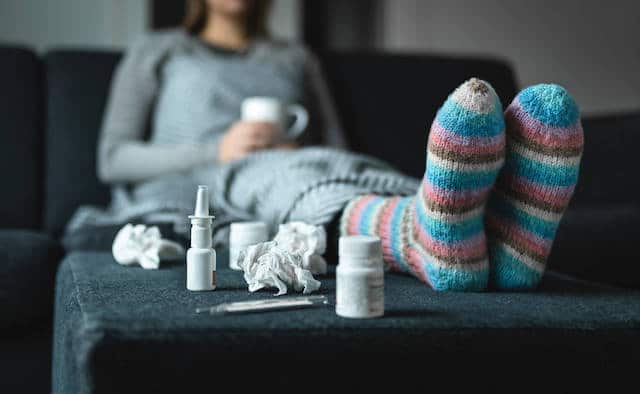
COMMON SYMPTOMS OF MOLD TOXICITY INCLUDE:
- Headaches or migraines
- Sinus problems
- Coughing
- Other respiratory issues
- Rashes
- Hair loss
- Digestive issues
- Brain fog
- Chronic fatigue
- Other neurological problems
Like the answer to “Does mold smell?”, the answer to “Can mold impact health?” has a similar response: it could, but it depends. Its ability to cause health issues is reason enough to actively work to avoid it growing in our indoor environments.
DOES MOLD SMELL? SOMETIMES, SO HOW DO YOU KNOW IF YOU HAVE A PROBLEM?
Indoor mold growth can be tricky to detect. Scent is one piece of the puzzle, but as mentioned earlier, not all mold growth creates an odor. So, how do you know if there’s a problem?
STEP ONE: USE YOUR NOSE
Obviously, sniffing around the home, particularly hotspots, can be the first step. If you smell a musty, earthy, damp scent, that could indicate a problem.
Another interesting point is that some individuals are more sensitive to mold and will detect the odor, while others may not. It’s similar to how some people will react strongly to scents like patchouli, while others barely take notice. So, if someone mentions a musty smell but you smell nothing, do not immediately discount it.
STEP TWO: TAKE A LOOK AROUND
While you’re sniffing around, grab a flashlight and go through every nook and cranny of a home. With so many species of mold existing across the planet, growth can come in a variety of colors and textures. This includes green, black, blue, brown, pink, white, grey, red, or a combination thereof; and velvety, slimy, fuzzy, or powdery. Any abnormalities like this can indicate a problem.
If during your search you smell mold but don’t visually see it, that doesn’t mean that there isn’t a problem. Mold could be growing in a hidden place, like inside the walls or underneath the flooring. Whether you experience both indicators or only one of the two, it can still point to a problem.
STEP THREE: PAY ATTENTION TO YOUR BODY
To make things even more difficult, not all mold growth smells, and it may not be a visible colony either. In these cases, it’s important to pay attention to how you feel. If you’ve been experiencing random chronic symptoms with no clear underlying cause or symptoms that develop in certain areas of the home, this could indicate an indoor contamination problem.
Our bodies are incredibly powerful warning systems that will alert us when there’s something not quite right. If symptoms are popping up, it could be telling you that something in your indoor environment is coming into the body and causing a ruckus. It’s up to us to listen to these signals and respond appropriately.
SMELL MOLD?
Yes, mold oftentimes smells! But, while we know the answer to “Does mold smell?”, what should you do if this odor pops up in your home?
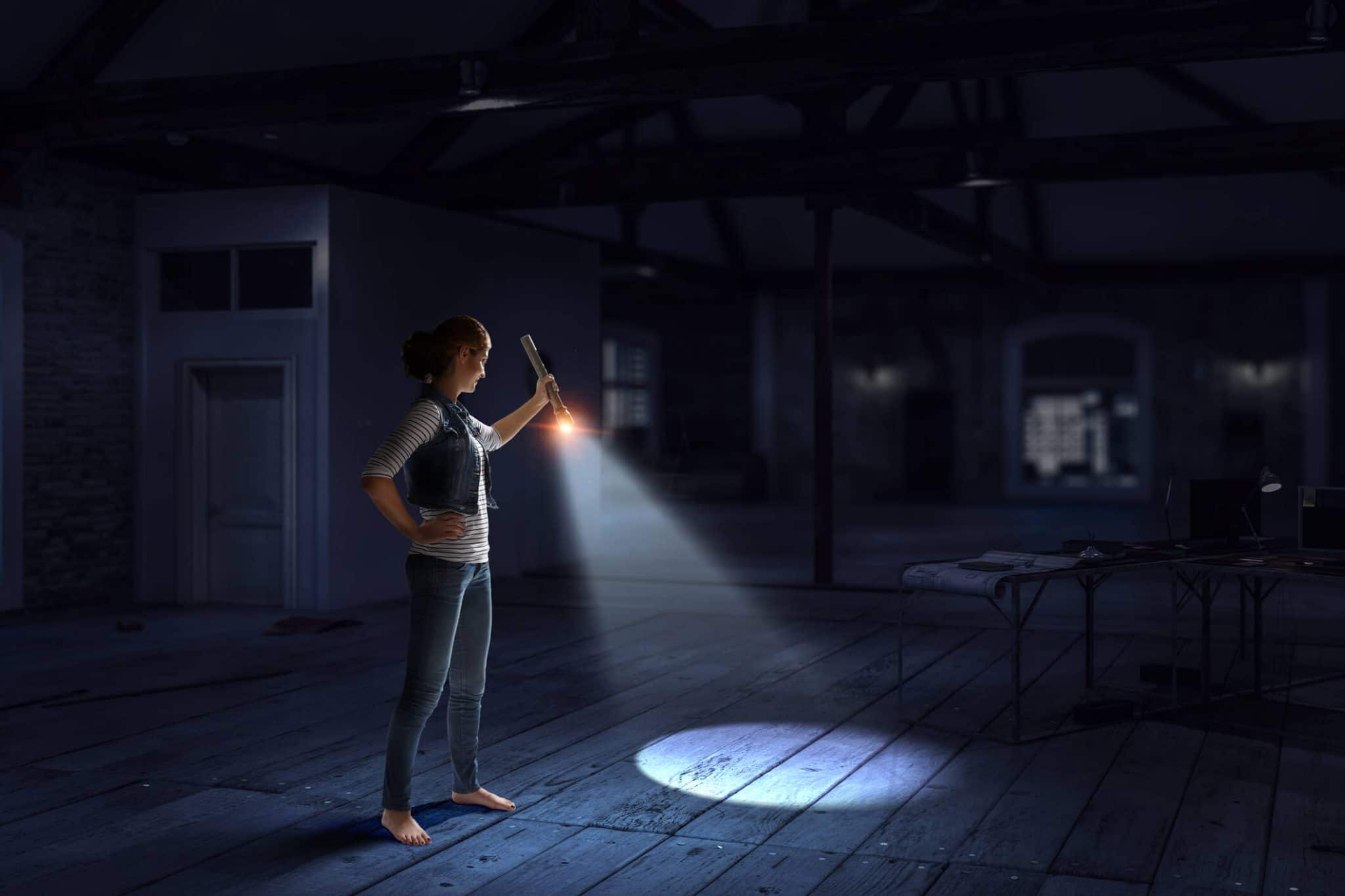
Your first step should be to identify where that smell is coming from. Take a look around to determine if you can find any visible mold. Make sure to look in places such as appliances, underneath sinks, crawlspaces, basements, attics, and any other area you can access.
If you happen to find the growth, you’ve then got to figure out how to get rid of it properly so that the exposure stops and the indoor environment once again becomes a safe space. If it’s a small enough problem, you may be able to handle it on your own. This will include the right tools, a thorough remediation process, and decontamination of the surrounding space.
Keep in mind that all of the particles have to be removed in order for the exposure to stop. This includes the roots of mold, dead particles, mycotoxins, and bacteria, which are often found right alongside mold growth.
The HomeCleanse Shop has HomeCleanse DIY and HomeCleanse Cleaning kits available, with many of the tools needed for a remediation project and decontamination afterwards.
-

EuroClean 4 Gallon Hepa Vacuum
The Euroclean GD930HSP is a 4 Gallon Dry HEPA Vacuum that meets the EPA's standards...
-
$849.00 Shop Now -
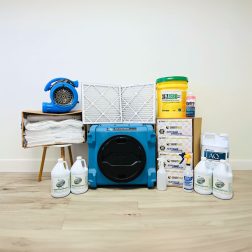
HomeCleanse DIY
All the equipment and materials we use to remediate your home, plus consultation and support...
-
Shop Now -

HomeCleanse Cleaning
Take your cleaning to the next level buying all the tools we use to keep...
-
Price range: $299.00 through $549.00 Shop Now
LARGER PROBLEMS
If it’s a more extensive project or you smell mold but can’t figure out where it’s coming from, it’s best to go ahead and bring in a qualified mold inspector. Not all mold inspectors are built the same, however, so make sure you go with an individual who understands the importance of creating a safe indoor space for you and your family and has experience taking the appropriate steps to ensure you have everything you need to achieve this success.
The inspection itself should take a few hours at least, span the inside and outside of the home, and be incredibly comprehensive; the more data, the better. An inspector should use a variety of testing methodologies throughout the whole home.
THE DATA YOU SHOULD EXPECT TO SEE INCLUDES:
- Species of mold present
- Presence of mycotoxins
- Mold presence in the HVAC system
- Quantities of each mold
Collectively, this will provide an accurate snapshot of the state of your indoor environment that will act as a guide for a remediation protocol. With this information in hand, you will have what you need to hire a qualified remediation team to come in and decontaminate the space so that you and your family can breathe easier. Like mold inspectors, though, not every remediation team will be the right one for your project.
The remediation team you choose should likewise understand the importance of creating a safe indoor environment and have proven experience with helping create safe spaces that allow healing. Any remediation team with these goals in place should always create a protocol based on three pillars for success.

THESE THREE PILLARS ARE:
- Remove the sources
- Resolve the problems that led to the mold growth in the first place
- Eliminate the contamination in the space, including other particles like mycotoxins
If any of these boxes aren’t checked, you and your family could continue to suffer. For instance, contaminants left behind can lead to prolonged exposure and any sources not resolved can allow the mold growth to come right back. All of these scenarios result in a toxic indoor environment.
HOW TO PREVENT MOLD GROWTH
Does mold smell? Sometimes; having awareness will help detect a problem even faster, and allow for remediation steps to be taken ASAP. However, how you can avoid it altogether is an even better question.
Preventing mold ultimately involves removing the necessary components for growth. Aka, moisture and food sources. Eliminating food sources can be tricky, as many building components are edible options for mold, but it’s a great option to help avoid mold in places like the coffee machine and refrigerator water spout.
ACTIONS TO PREVENT MOLD GROWTH INCLUDE:
- Maintaining indoor humidity between 35-50%¹⁴
- Deep cleaning often, using botanical cleaners, a HEPA vacuum, and microfiber towels
- Regularly checking moldy hotspots throughout the home
- Scheduling an HVAC technician to service the machine in the spring and fall
- Cleaning up spills and fixing leaks immediately
- Keeping windows and doors closed on rainy days
- Having a wellness inspector come to assess the house for any structural issues that could lead to mold growth
- Create airflow in bathrooms and kitchens by turning on vents and cracking windows and doors
- Investing in air purification
- Opting for the highest-rated MERV filters the HVAC unit can handle
This isn’t a complete list, but it’s a great place to get started on maintaining a safe indoor environment.
CREATING AN ODORLESS HOME

Bad smells can easily pop up in a home, but they don’t always signal that toxins could be floating around in the air and making their way into the body. Unfortunately, this indoor contaminant doesn’t get nearly as much attention in society as it should. With its ability to affect health, this situation is a bit baffling.
That’s why we’ve all got to work on increasing our personal awareness of mold and knowing the answer to questions such as, “Does mold smell?” The sooner we detect an issue in a home, the less contamination will be blown all throughout the indoor space, and the lower the exposure will be. Everyone deserves to live in a healthy indoor space that promotes their ongoing wellbeing.
Health begins at home.™
Still Have Questions?
A member of our team is here to help! Click on “Get Started ➤” below to book a consultation with a member of the HOMECLEANSE team. We have a few quick questions that will help us put together a roadmap to solve or prevent all of your mold problems.
Two minutes of your time could lead to better health for you and your family.
Build Your Home Health Arsenal
-

EC3 Laundry Additive
Add EC3 to every rinse cycle to rinse away mold, bacteria and musty odors from...
-
$23.00 Shop Now -

HomeCleanse Cleaning
Take your cleaning to the next level buying all the tools we use to keep...
-
Price range: $299.00 through $549.00 Shop Now -

Mold & Bacteria Contents Cleaning
Remove harmful pollutants that accumulate in the dust of your home. (Options available for renters...
-
Price range: $99.00 through $349.00 Shop Now -

EC3 Mold Solution Concentrate
Micro Balance EC3 Mold Solution Concentrate is a natural botanical that removes mold spores, bacteria,...
-
$33.00 Shop Now -

Industry-Leading Intellipure Ultrafine 468
The Intellipure® Ultrafine 468 features our proprietary DFS technology, which traps and eliminates potentially harmful...
-
Shop Now -

The Dust Test
The Dust Test is a comprehensive at-home test that helps you identify mold and toxins...
-
$299.00 Shop Now -

EuroClean 4 Gallon Hepa Vacuum
The Euroclean GD930HSP is a 4 Gallon Dry HEPA Vacuum that meets the EPA's standards...
-
$849.00 Shop Now -

AprilAire E080 Professional Dehumidifier Bundle
Includes all the dehumidifier accessories you will need. Our Aprilaire E080 comes with a drain...
-
$1,524.99 Shop Now
- Environmental Protection Agency. (n.d.). Mold. EPA. Retrieved from https://www.epa.gov/mold.
- Centers for Disease Control and Prevention. Basic facts about mold and dampness. Centers for Disease Control and Prevention. Retrieved from https://www.cdc.gov/mold/faqs.htm.
- Lstiburek, J., Brennan, T., & Yost, N. (2002, January 15). Rr-0208: What you need to know about mold. Building Science Corporation. Retrieved from, https://www.buildingscience.com/documents/reports/rr-0208-what-you-need-to-know-about-mold/view.
- World Health Organization. (n.d.). Mycotoxins. World Health Organization. Retrieved from https://www.who.int/news-room/fact-sheets/detail/mycotoxins.
- Environmental Protection Agency. (n.d.). What does mold smell like? EPA. Retrieved from https://www.epa.gov/mold/what-does-mold-smell.
- Nchh. (n.d.). Mold. NCHH. Retrieved from https://nchh.org/information-and-evidence/learn-about-healthy-housing/health-hazards-prevention-and-solutions/mold/
- Curtis, L., Lieberman, A., Stark, M., Rea, W., & Vetter, M. (2004). Adverse health effects of indoor molds. Journal of Nutritional & Environmental Medicine, 14(3), 261-274.
- Bush, R. K., Portnoy, J. M., Saxon, A., Terr, A. I., & Wood, R. A. (2006). The medical effects of mold exposure. Journal of Allergy and Clinical Immunology, 117(2), 326-333
- Fisk, W. J., Lei-Gomez, Q., & Mendell, M. J. (2007). Meta-analyses of the associations of respiratory health effects with dampness and mold in homes. Indoor air, 17(4), 284-296.
- Wild, C. P., & Gong, Y. Y. (2010). Mycotoxins and human disease: a largely ignored global health issue. Carcinogenesis, 31(1), 71-82.
- Environmental and Occupational Health Assessment Program, & Environmental and Occupational Health Assessment Program, & Health Science Section, Mold Basics for Primary Care Clinicians (2009). Hartford, CT; Connecticut Department of Public Health. , H. S. S., Mold Basics for Primary Care Clinicians 1–10 (2009). Hartford, CT; Connecticut Department of Public Health.
- Chauhan, B., Santiago, L., Kirschmann, D. A., Hauptfeld, V., Knutsen, A. P., Hutcheson, P. S., … & Bellone, C. J. (1997). The association of HLA-DR alleles and T cell activation with allergic bronchopulmonary aspergillosis. The Journal of Immunology, 159(8), 4072-4076.
Chicago - Knutsen, A. P., Vijay, H. M., Kumar, V., Kariuki, B., Santiago, L. A., Graff, R., … & Shah, M. R. (2010). Mold‐sensitivity in children with moderate‐severe asthma is associated with HLA‐DR and HLA‐DQ. Allergy, 65(11), 1367-1375.
Chicago - EPA. (n.d.). A Brief Guide to Mold, Moisture, and Your Home. EPA. Retrieved from https://www.epa.gov/mold/brief-guide-mold-moisture-and-your-home#tab-6.
Still Have Questions?
A member of our team is here to help! Click on “Get Started ➤” below to book a consultation with a member of the HOMECLEANSE team. We have a few quick questions that will help us put together a roadmap to solve or prevent all of your mold problems.
Two minutes of your time could lead to better health for you and your family.
Must-Have Indoor Air Quality Tools
-

EC3 Laundry Additive
Add EC3 to every rinse cycle to rinse away mold, bacteria and musty odors from...
-
$23.00 Shop Now -

Intellipure Compact Air Purifier
Small in size, but delivers powerful results, reducing airborne microorganisms like mold, viruses, and bacteria.
-
$649.00 Shop Now -

Intellipure SuperV Whole House Air Purifier
Turn your HVAC into a filtration system, removing 99% of ultrafine particles including airborne mold,...
-
Price range: $2,000.00 through $2,995.00 Shop Now -

HomeCleanse Cleaning
Take your cleaning to the next level buying all the tools we use to keep...
-
Price range: $299.00 through $549.00 Shop Now -

Mold & Bacteria Contents Cleaning
Remove harmful pollutants that accumulate in the dust of your home. (Options available for renters...
-
Price range: $99.00 through $349.00 Shop Now -

EC3 Mold Solution Concentrate
Micro Balance EC3 Mold Solution Concentrate is a natural botanical that removes mold spores, bacteria,...
-
$33.00 Shop Now -

Industry-Leading Intellipure Ultrafine 468
The Intellipure® Ultrafine 468 features our proprietary DFS technology, which traps and eliminates potentially harmful...
-
Shop Now -

The Dust Test
The Dust Test is a comprehensive at-home test that helps you identify mold and toxins...
-
$299.00 Shop Now -

EuroClean 4 Gallon Hepa Vacuum
The Euroclean GD930HSP is a 4 Gallon Dry HEPA Vacuum that meets the EPA's standards...
-
$849.00 Shop Now -

AprilAire E080 Professional Dehumidifier Bundle
Includes all the dehumidifier accessories you will need. Our Aprilaire E080 comes with a drain...
-
$1,524.99 Shop Now
